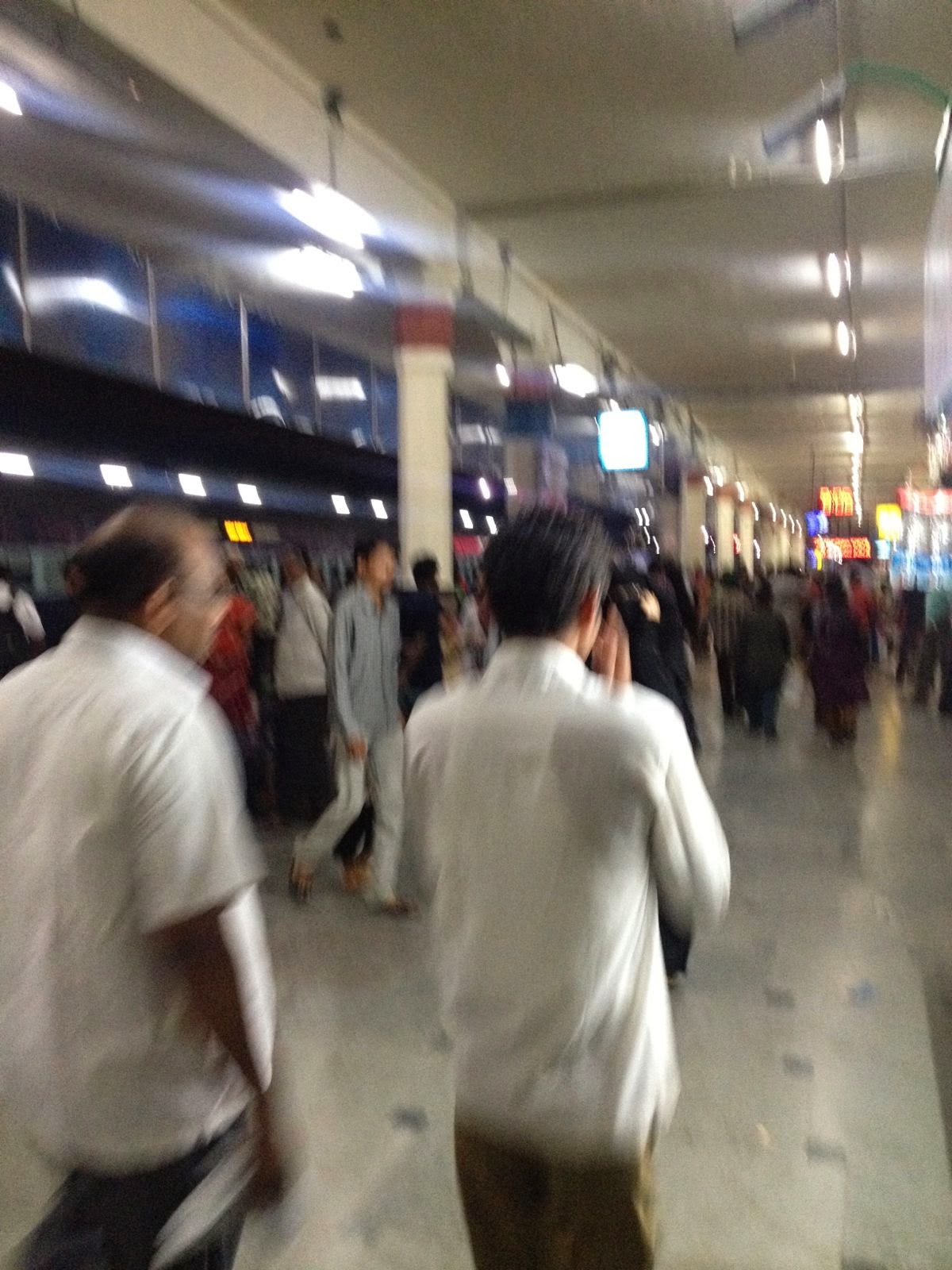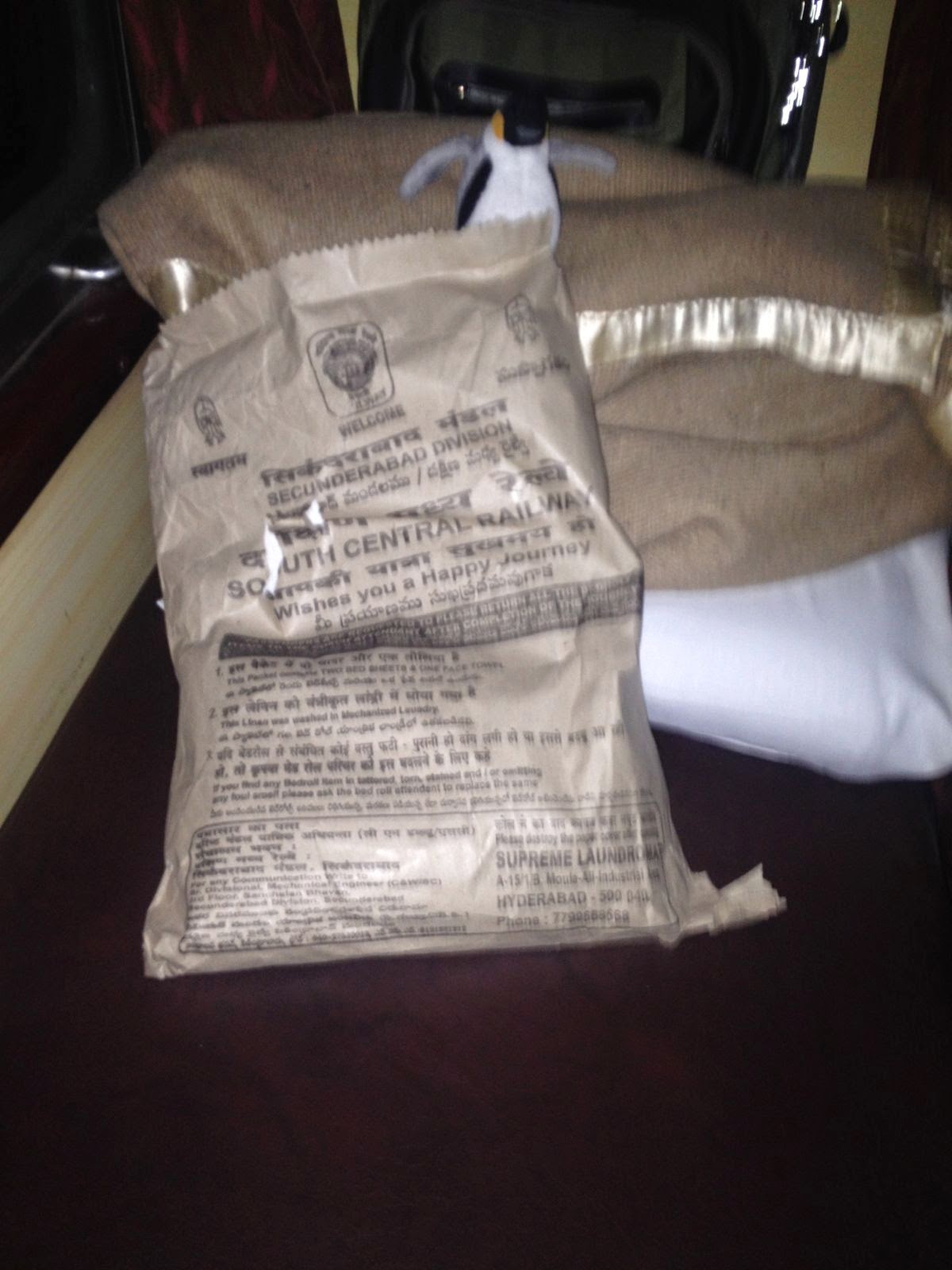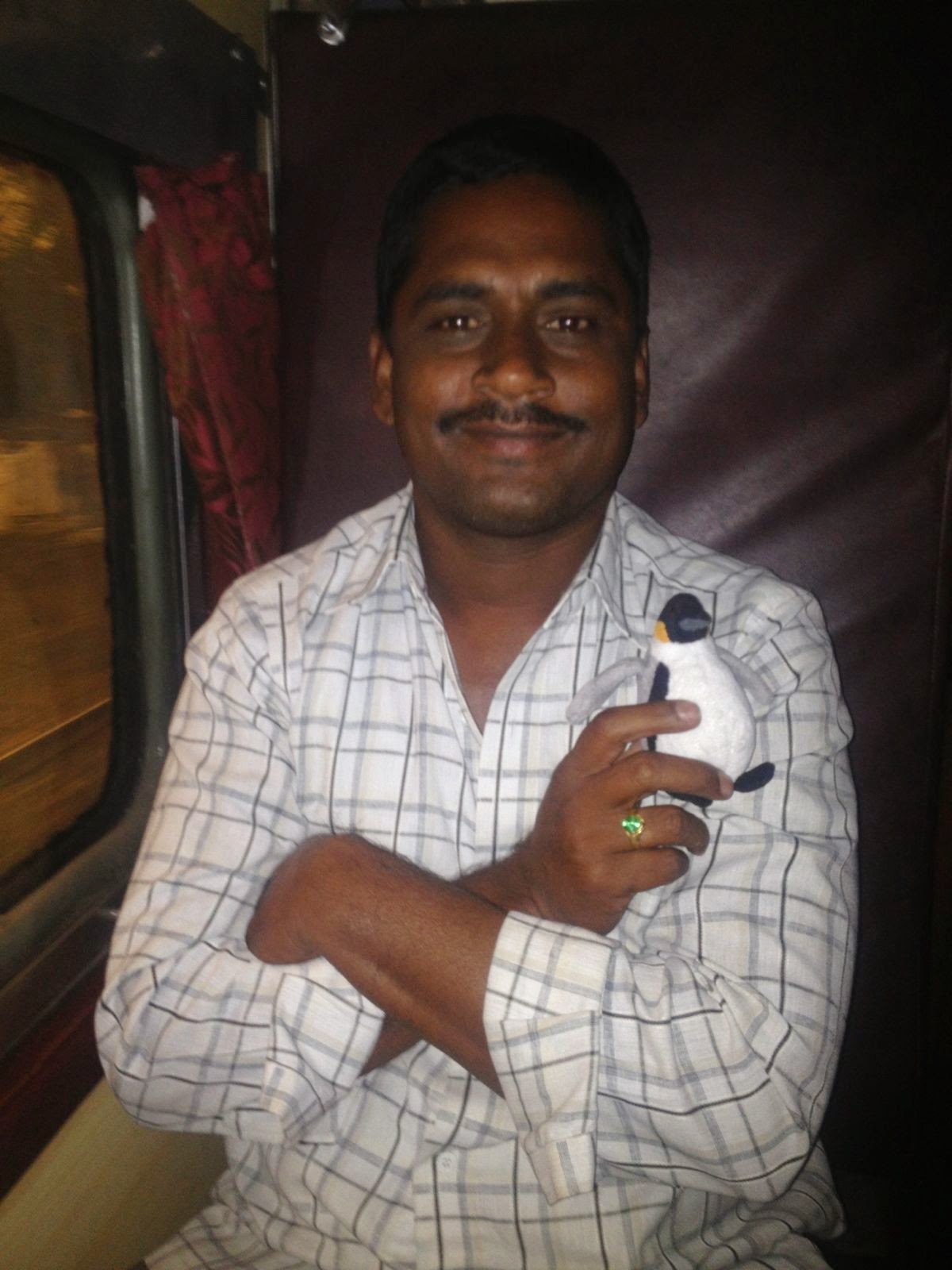Penguin and I ultimately decided to take a cab to Nampally railway station. I was going to take the commuter train, but the timing was such that I would’ve had to burn an hour at the railway station, which normally would be fine but I needed to use the time to do work while I still had Internet access.
My cab driver was super helpful and pointed out that we were making good enough time that we could stop to get me a take-out dinner to eat on the train, and he took me to the take-out outpost of Paradise, which is supposed to have the best biryani in Hyderabad (which is itself known as the biryani capital of India). I appreciated this since I would otherwise have left here without having any (the hotel restaurant didn’t come highly recommended).
With take-out biryani and Kingfisher beer in hand, we arrived at the railway station. I was the only Westerner in (or anywhere near) the station, and as far as I can tell, I was the only Westerner on the train, and I saw no Westerners at any of the station stops for which I was awake.
The station was busy, but not ridiculously so (by the standards of, say, Grand Central, though this small station was much more modest); the most impressive thing was actually how long the platform was. (Sorry for the blurry picture, I was trying to stay out of people’s way)

These trains are about 15-20 cars long – nearly twice as long as long-distance US trains – and the platform is easily a quarter mile end-to-end. All but three or four of those 20 cars were “sleeper class”, which misleadingly means “unreserved”: you get a ticket, but not a reserved berth, so you fight/negotiate for sleeping/seating space once on board.
I was in 2nd AC (air conditioned), which is reserved seating, and arranged like this:
(w is a window; > is a seat and points the way you’re facing when you sit; vertical lines are bench seats)
--- w ----- w ------ w -----
> < > < > <
(aisle) (aisle) (aisle) .... (bathrooms)
| | | | | |
| | | | | |
--- w ----- w ------ w -----
---> travel direction --->
Here’s a short video tour of our seating area.
On the single-seats side (upper row), where I was sitting, there is a cot overhanging the two facing seats; at night, the seat backs fold down so the two seats become a lower cot, and the two passengers who had been facing each other take the upper and lower cots, which are parallel to the direction of travel. On the bench-seat side of the train, there is a cot overhanging each bench, so the benches and cots are perpendicular to the direction of travel; the benches become cots at night. Curtains you can draw provide some privacy from the aisle. Before the train left the station, an attendant came around and placed a pillow, a blanket, and a paper-wrapped package of freshly-laundered sheets on each cot.

Unlike Amtrak, you do the seat-to-bed conversion yourself and negotiate with your seatmate as to when the seats fold up and down. Our seatmate goes by Reddy (I can’t pronounce his first name)…

It is a little bit tricky to maneuver things in and out of your carry-on if you haven’t staged the stuff you need for the ride–we mostly had–but once you’re settled, it’s cozy but not at all uncomfortable. The only comfort issue is that the straight-backed seats do not recline, though that seems to be the same in all classes, even in 1st class AC; some trains (not mine) have “executive chair cars” which resemble what we are used to on American trains, with big reclining seats. Also, if passengers on the opposite side of the train from you choose to keep their curtain drawn during the day, you cannot see out of both sides of the train and the interior can be somewhat dark.
Everyone knows Americans are loud, but Indians are REALLY LOUD!!! AND THEY TALK FAST!!!!! AND CONSTANTLY!!!!!!!!!!! Here is an approximate transliteration of the first few seconds of what I heard from the group across the aisle:
I was concerned it would be impossible to sleep, but after the first few stops the lights were turned out and people quieted down. The earplugs, blindfold and Benadryl definitely helped. (And during the day, so did my blessed Bose noise-cancelling headphones.)
The equipment is sturdy and aging – the machinery is vintage 1950’s – but gives the impression of being in good repair. I walked part of the train and tried to discreetly capture some footage without being rude. This train has a 1st AC coach (cabins with doors rather than curtains; the cabins and berths are larger than 2AC, but there are four per cabin), 3rd AC (like 2nd, but stacked three-high instead of double-high), and Sleeper (like 3AC, but packed closer together and unreserved, so you have to jockey for seats). I was unable to move from the 3AC car into the Sleeper cars because they were packed with people - walking through one would be like walking through a New York subway car at rush hour, with people sitting in the aisles and car vestibules as well as occupying every square foot of bench/cot space. Each car has both an Indian-style squat toilet and a Western-style toilet (though both have signs with the ominous admonition “Do not use while at station”, which gives you a clue as to where the toilet contents go when you flush). Nowhere did I see filth or anything disgusting; it is certainly crowded, but everything was sanitary. There were no chickens on board or anything like that. In fact, when I opened my beer, the conductor quickly admonished me that beer is not allowed on the train, so I had to ditch it, which was disappointing since it would have gone well with the biryani.
It took a little shuffling things around for penguin and I to get ready for bed, but once we did, it was fine. The only issue (which I also experience backpacking) is that the padding on the cots is pretty spare, so it’s about like sleeping on a Thermarest, which makes me a bit sore; but overall I woke rested at about 6:30am.
Once morning came, Reddy and I folded the seats down and proceeded to have a long conversation. He works in business contracts, so I assume he’s representative of a typical middle class Indian working guy. He was curious about my iPhone, and with that wonderfully compressed sense of personal space that so many Indians have, he proceeded to look at every photo and ask me questions about it: where is that? who is that? what’s going on in this photo? But it was all more like the charm of a curious child than nosiness. He wanted to know about life in the US as narrated through my pictures. Do people take the train there? (He was astounded to learn that it takes 3 days to get from New York to California by train, since no two points in India are that far apart.) How many states are there? Is Texas a country? (It was tough to answer truthfully.) When people vote in elections, what symbol goes with each candidate on the ballot? (It took me awhile to figure that out. Because of the high illiteracy in India, each candidate is associated with a pictorial icon, which also appears on the ballot.) How long was your flight? Why don’t you have children? Do you live with your parents? (In India, as in much of Asia, the presumption is that children will take care of their parents when they get old, usually by moving back in with them or living very close by.)
The other great thing that happened once morning came is the food vendors. Most overnight trains here don’t have kitchens or dining cars: instead, individual food vendors get on and off at different stations and roam the train selling bottled water, packaged snacks, masala chai, chai coffee (I had four little cups, just 10 rupees each, which is about 15 cents), baked goods (I had a couple of fried dough things stuffed with chickpeas), “bread omelets” (basically an omelet sandwich), and more. There’s some remote possibility that the food had been reheated rather than recently cooked, but there is so much turnover that I doubt it.

In short, the trains work. There is no luxury or glamour on board (or beer), and it’s not particularly fast, but every available seat is filled: there is a waitlist system in which, at the second station of a long-distance train, a waitlist of people (who have pre-reserved a spot on the waitlist!) are given seats that were reserved for no-shows who didn’t board at the origin station. (There is no “standby list” in the airline sense; the pre-reserved waitlist can rarely be fully accommodated.) People behave very chill (for Indians, loudly talking in a continuous stream of short syllables is chill) and, modulo no beer, you don’t go hungry during the ride. The onboard equipment, while dated, seems to work; in fact the railway is the only thing I’ve seen so far that isn’t an unmitigated infrastructural disaster.
…and just like that, we’re on the far outskirts of Mumbai, and the mountains of garbage perhaps concealing a haunting Malthusian reminder that maybe India just cannot handle the sanitation needs of this many people (18% of the world’s population in less than 3% of the world’s land area). Every kind of construction props up “informal dwellings” - cinderblock walls and corrugated metal roof is at the high end, bamboo framing with palm leaves or cardboard boxes for walls at the low end.
Now passing through residential developments – lots of dense high-rises, as on the outskirts of Hong Kong, with more under construction. We’re speeding through train stations where people are boarding overflowing commuter trains. Those trains travel at full speed with all doors open and people hanging out of the doors. (Note to self: I want to try that.) Two Western-dressed Asian girls with roll-aboard suitcases - maybe college age - are standing on the platform; they’re the first non-Indians I’ve seen since boarding in Hyderabad, and they look like nonlocals because the other people waiting for the train are sleeping or sitting on blankets, whereas these two are standing up, looking around, one hand on suitcase.
After hotel check-in, it’ll be time to do a little exploratory walk of south Mumbai, the area where most of the colonial construction and development occurred!